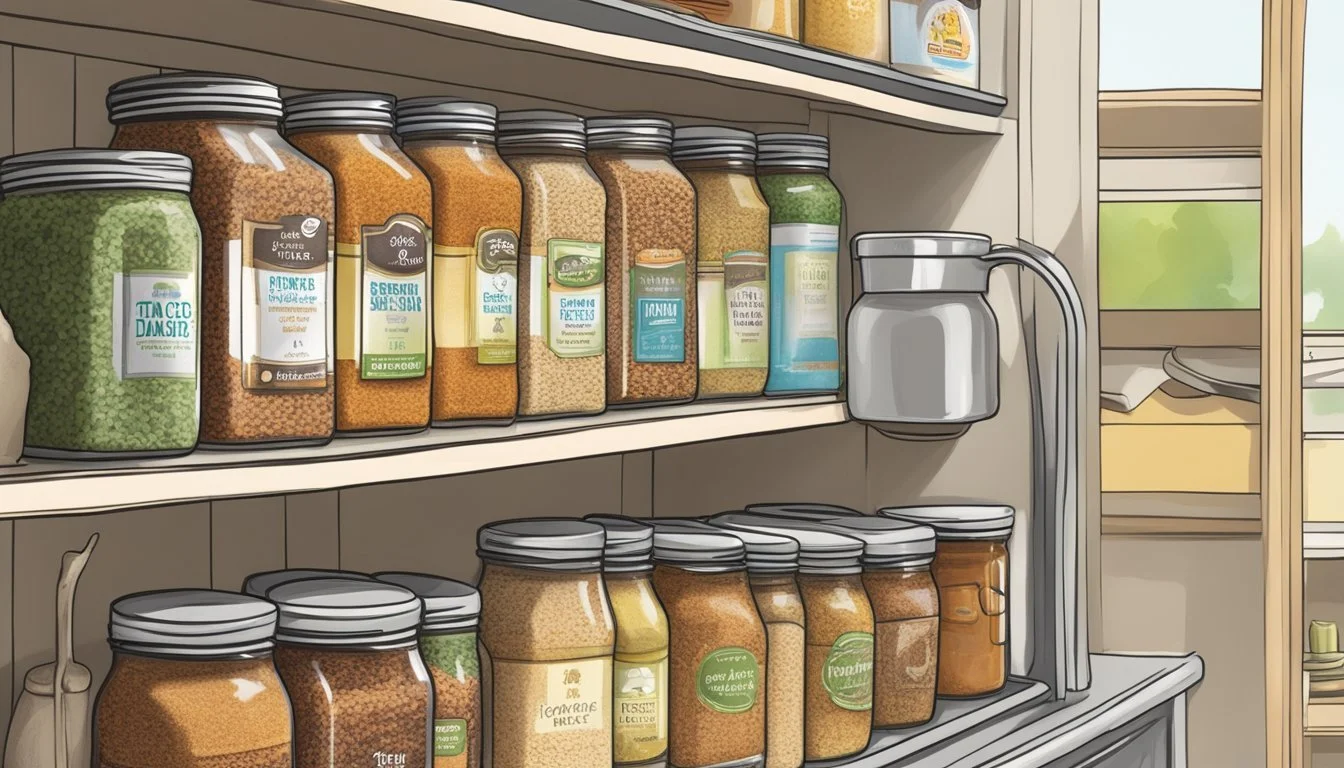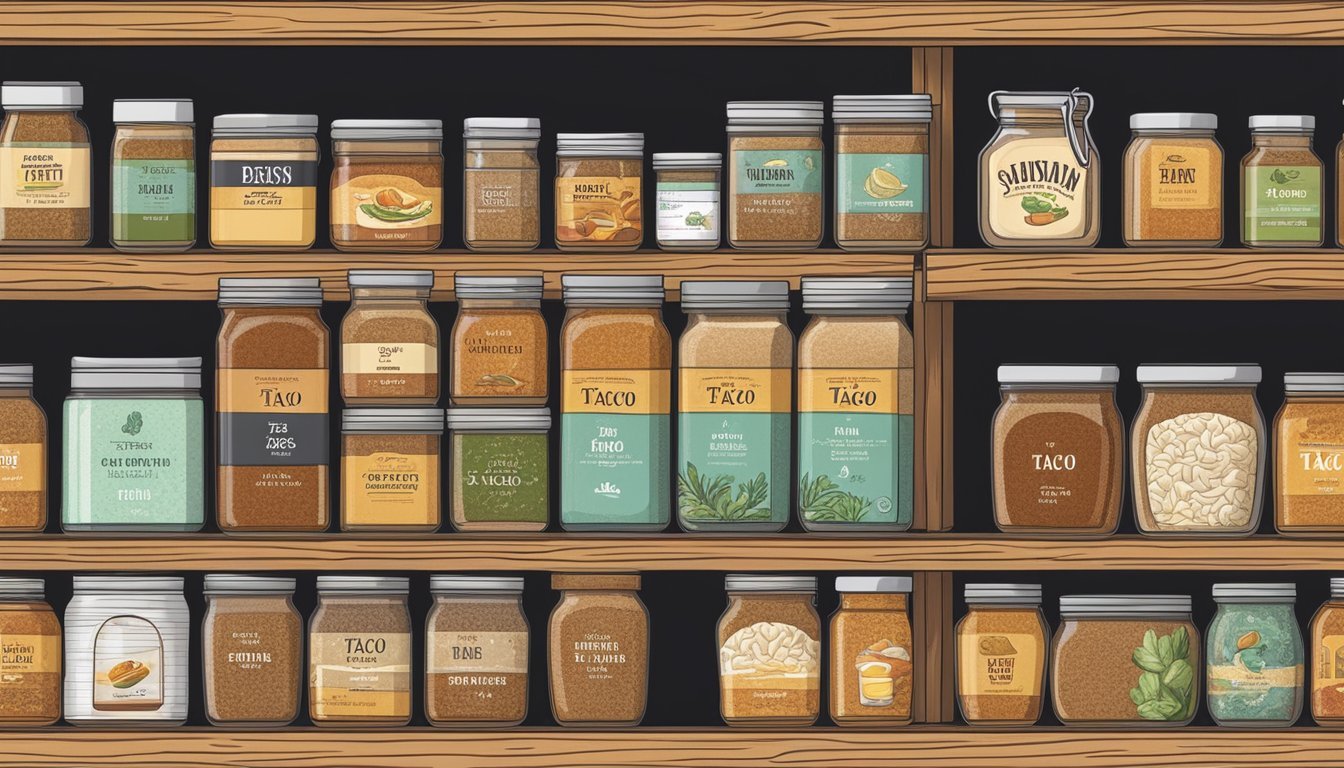How Long Does Taco Seasoning Last?
Shelf Life and Storage Tips
Taco seasoning, a blend of spices commonly used to flavor Mexican-inspired dishes, boasts a place in many kitchens due to its convenience and the robust taste it imparts to food. It typically includes ingredients such as chili powder, cumin, garlic powder, (how long does garlic powder last?) onion powder (how long does onion powder last?), paprika, and sometimes salt and black pepper, among others. Its shelf life is generally long, thanks to the dried and ground nature of its components, which are known for their preservative qualities when stored properly.
The longevity of taco seasoning hinges on how it's stored. Kept in a cool, dry place and in an airtight container, it can retain its best quality for about 2-3 years. While taco seasoning does not spoil in the traditional sense like fresh produce or dairy products, it can lose potency over time, leading to a milder flavor profile. Consequently, even if taco seasoning surpasses its recommended shelf life, it may still be safe for consumption, but with diminished flavor.
Understanding Taco Seasoning
Taco seasoning is a vital component in creating the authentic taste of Mexican cuisine. It is a spice blend that elevates dishes with a complex flavor profile developed from a combination of various spices and herbs.
Composition and Ingredients
The typical taco seasoning mix consists of a variety of ingredients that are carefully selected to achieve a balance of flavors. These ingredients usually include:
Chili powder: The base for most taco seasonings, providing a mild heat and deep color.
Ground cumin: Adds a warm, earthy tone that is central to the mix's flavor.
Garlic powder: Offers a pungent, aromatic quality.
Dried oregano: Introduces a slightly bitter and earthy note.
Paprika: Contributes to the seasoning's vibrant color and sweet undertones.
Onion powder: Adds a subtle sharpness and depth.
Salt: Enhances the overall flavor of the mix.
Black pepper: Provides a piquant taste that complements the other spices.
These core components work in tandem to form the distinctive taste of taco seasoning. It is common for homemade taco seasoning recipes to vary in proportions to cater to personal taste preferences.
Varieties and Flavors
While the classic taco seasoning is known for its warm, spicy flavor profile, there are several variations catering to different palates:
Mild Versions: These typically contain less chili powder and black pepper, suitable for those who prefer less heat.
Bold varieties: May feature increased quantities of cumin or chili powder for a more intense flavor.
Specialty Blends: Some might include additional spices such as chipotle or ancho chili powder, adding a smoky dimension.
The versatility of taco seasoning allows for a wide range of flavors, making it an adaptable mix that can suit a variety of recipes and individual tastes. Whether store-bought or homemade, the quality of the ingredients and the combination of spices used define the overall character of the taco seasoning.
Shelf Life Fundamentals
When it comes to the shelf life of taco seasoning, understanding the preservation of quality and safety is crucial. The shelf life is typically 2-3 years, but it can vary depending on certain factors and adherence to expiration dates.
Expiration Date Significance
The expiration date on a taco seasoning package serves as the manufacturer's guarantee of peak quality and flavor. This date indicates the timeframe during which the product is expected to retain its intended taste profile if stored properly. Consumers should note that while a taco seasoning may be safe to consume after the expiration date, the quality in terms of flavor and potency may diminish.
Factors Affecting Shelf Life
Several key elements influence the shelf life of taco seasoning:
Storage Conditions: To maximize longevity, store taco seasoning in a cool, dry place away from heat and moisture, which can lead to clumping and flavor loss.
Product Packaging: Factory-sealed packaging offers more protection than aftermarket containers, contributing to a longer shelf life.
Humidity and Temperature: These environmental factors can accelerate the degradation process, potentially reducing shelf life and quality.
Frequency of Use: Each time the seasoning is used, it is exposed to air and environmental factors that may affect its overall shelf life.
By considering these aspects, one can ensure that their taco seasoning remains as fresh and flavorful as possible for as long as possible.
Proper Storage Techniques
Storing taco seasoning correctly is pivotal for maintaining its flavor and extending its shelf life. Proper storage techniques can preserve the seasoning's quality by protecting it from adverse conditions.
Ideal Conditions
Temperature and Humidity: Taco seasoning should be stored in a cool and dry place to prevent the degradation of its flavor and potency. Ideal storage temperature should remain consistent and cool, preferably between 60-70°F (15-21°C). High humidity levels can introduce moisture, which may lead to clumping, loss of texture, and possible spoilage.
Light Exposure: Direct light, especially sunlight, can degrade the flavors in taco seasoning. It's advisable to store the seasoning in a cupboard or pantry to minimize exposure to light.
Containers and Packaging
Airtight Containers: Storing taco seasoning in an airtight container is essential to prevent exposure to air and moisture, both of which can reduce the seasoning's lifespan. Glass jars with tight-fitting lids or plastic containers with seals are excellent choices for prolonging freshness.
Original Packaging: If unopened, the original packaging can suffice, provided that it's kept sealed and stored under the ideal conditions mentioned. Once opened, transferring to an airtight container is recommended.
Labeling: Always label storage containers with the date of purchase or opening. This practice helps keep track of how long the taco seasoning has been stored and ensures it is used within its best quality period.
Identifying Spoilage
When examining taco seasoning for spoilage, one should look for discoloration and alterations in aroma or flavor, which can indicate that the seasoning is no longer at its best quality for use.
Visual and Textural Changes
Color: An obvious sign of spoilage in taco seasoning can be a change in color. Fresh taco seasoning typically has a vibrant color, depending on the specific spices used. If the seasoning appears faded or has a dull appearance, this could suggest degradation.
Texture: Another indicator is the texture of the seasoning. It should be free-flowing. If one finds clumps or lumps, which often occur due to moisture, it might not only affect the texture but could also be a breeding ground for mold.
Odor and Taste Assessment
Smell: Taco seasoning should have a potent and spicy aroma. A sign of spoilage is if the seasoning has a musty or an off odor, it likely indicates that it is no longer suitable for consumption.
Taste: If the appearance and smell seem acceptable but there's still doubt, a tiny taste can be telling. If there's a significant loss in flavor or if the seasoning tastes different from when it was fresh, it's likely that it has spoiled.
In identifying spoilage, it is imperative to trust one's senses and err on the side of caution. If the seasoning shows any signs of mold, it should be discarded immediately.
Maximizing Spice Potency
Maintaining the potency of taco seasoning is crucial to ensure that every dish prepared with it delivers the intended flavor profile. Proper storage and timely replacement are key strategies in preserving the spice's integrity and strength.
Freshness Tips
Storage: The longevity and potency of taco seasoning hinge on appropriate storage conditions. Spices should be kept in airtight containers to prevent exposure to moisture and air, which can lead to spoilage. It’s imperative to store taco seasoning in a cool, dark place away from direct sunlight, heat, and humidity, as these factors can degrade the quality and lessen the spicy kick of the mixture.
Inventory Management: A practical approach to maintaining freshness is to purchase or make taco seasoning in quantities that can be used within a reasonable time frame. Buying in bulk is often economically appealing but may lead to a decline in freshness if the seasoning is not used before it begins to lose its potency.
Replacement and Rotation
Assessing Potency: Over time, even well-stored taco seasoning will gradually lose its strength, becoming less spicy and flavorful. The recommended period for optimal potency is about 2-3 years for store-bought and 6 months to 1 year for homemade seasoning mixes. A straightforward sniff test can help determine if the spice has diminished in piquancy—fresh spices will have a pronounced aroma, whereas stale spices will lack this olfactory punch.
Rotation Practice: Consistent rotation of spice inventory is advised, using a first-in, first-out (FIFO) method. When purchasing new seasoning, place it behind the older stock to ensure that older items are used up first. Marking the purchase or creation date on containers can aid in tracking how long the seasoning has been stored and help decide when it might be time to replace it.
Usage Applications
Taco seasoning serves as a versatile component in Mexican cuisine, enhancing flavors across a range of dishes. Its dynamic blend of spices makes it ideal for various culinary experiments beyond its typical use.
Culinary Uses
In the realm of Mexican food, (What wine goes well with Mexican food?) taco seasoning is a staple for preparing tacos and burritos, where it's used to season ground beef or other proteins, giving them a distinctive flavor profile. It's also commonly incorporated into Mexican-inspired dishes, adding a warm and savory spice mix that complements the ingredients traditionally found in these meals. Chefs frequently use taco seasoning in soups to add depth and a Mexican twist, showcasing its adaptability in cooking beyond just tacos and burritos. Here is a brief list of culinary uses:
Tacos: Sprinkle over meat or vegetables for authentic flavor.
Burritos: Mix with rice, beans, and protein to create a hearty filling.
Soups: A teaspoon can enrich broth-based soups with Mexican flair.
Mexican cuisine: Essential for traditional dishes like enchiladas and fajitas.
Non-Traditional Uses
Taco seasoning's robust flavor profile enables it to shine in non-traditional applications, transforming an average meal into something with a kick. Its ease of use makes it a go-to for those looking for a quick and easy flavor boost in everyday cooking. Some innovative uses of taco seasoning include:
Sprinkle on popcorn or mixed nuts (how long do mixed nuts last?) for a zesty snack.
Blend into mayonnaise or sour cream to create a flavorful dip.
Season roasted vegetables or potato wedges for an extra flavor dimension.
Stir into scrambled eggs or omelets for a Mexican inspired breakfast.
Safety and Health Considerations
When considering the safety and health aspects of taco seasoning, it is important to understand the implications of consuming expired products and the potential impact of allergens and additives.
Consuming Expired Seasoning
Expired taco seasoning typically does not become unsafe to consume, as it is a dry product less prone to bacterial growth. However, over time, the flavor and potency may decline, potentially leading to a less satisfying taste experience. Consumers should be aware that while the risk of foodborne illness is low, using taco seasoning past its optimal shelf life can result in a lackluster culinary outcome.
Allergens and Additives
Taco seasoning may contain additives and preservatives which extend shelf life and enhance flavor. Individuals should check for:
Preservatives: To maintain freshness.
Additives: Such as anti-caking agents.
These components are generally recognized as safe (GRAS) but may need to be monitored due to dietary restrictions or sensitivities. Moreover, taco seasoning can contain high levels of sodium, which could be a concern for those managing sodium intake for heart health or other conditions. Regarding nutritional aspects, consumers should consider portion sizes as seasonings can contribute to the overall nutritional profile of a meal.
DIY Taco Seasoning
Creating your own taco seasoning at home allows for a freshly made spice mix that is free from additives and can be customized to personal taste preferences.
Homemade Recipe Crafting
One begins crafting homemade taco seasoning by selecting quality spices and measuring them to create a balanced flavor profile. A typical recipe might include ingredients such as chili powder, ground cumin, garlic powder, onion powder, dried oregano, paprika, salt, and black pepper. Precise measurements ensure consistency, and mixing these components thoroughly guarantees even flavor distribution.
Example Recipe:
1 Tablespoon chili powder
1 Tablespoon ground cumin
1 teaspoon garlic powder
1 teaspoon onion powder
1 teaspoon dried oregano
1 teaspoon paprika
2 teaspoons sea salt (how long does sea salt last?)
1 teaspoon black pepper
After blending the spices, one should store the homemade taco seasoning in an airtight container to preserve its potency, typically maintaining peak freshness for about 2-3 months.
Customization and Variations
The beauty of homemade spice mixes lies in the ability to tailor them to individual tastes. One might add more chili powder for extra heat or include smoked paprika for a nuanced smokiness. For those seeking a lower sodium option, salt can be adjusted or eliminated.
Customization Ideas:
Add 1/2 teaspoon cayenne pepper for a spicy kick
Mix in 1 teaspoon smoked paprika for added smokiness
Reduce salt by half for a lower sodium alternative
By incorporating or omitting certain spices, or even adding fresh herbs like cilantro or lime zest, cooks can create a unique ingredient profile that elevates their cooking.
Purchasing and Brand Comparison
When selecting a taco seasoning mix, one should consider both the convenience of purchase and the quality variations across different brands. This section will examine the nuances of purchasing taco seasoning packets and the distinctions among popular brands.
Buying Guide
When purchasing taco seasoning mix, shoppers should be mindful of the spice blend's intended use and personal taste preferences. Seasoning packets offer a quick and easy solution for flavoring Mexican dishes and are widely available in the grocery store aisle. Buyers should look for packets that list spices and herbs as the main ingredients, with minimal preservatives or additives, to ensure a more natural flavor profile.
Quality Indicators: Freshness can be gauged by checking the "Best By" date.
Flavor Profile: Opt for seasoning packets that match one's desired heat level and flavor complexity.
Size: Packets come in various sizes, from single-use to bulk containers.
Product Reviews
Several brands offer taco seasoning mixes, each with its unique blend of spices and herbs. Consumers may prefer certain brands over others based on taste, price, or ingredient quality.
Brand A: Known for a traditional flavor, it often includes a blend of chili powder, garlic, and oregano.
Brand B: Might offer a lower sodium option for those watching their salt intake.
Brand C: Could be favored for organic ingredients with no artificial additives.
Selecting the right taco seasoning mix is a balance between the convenience of pre-mixed packets and the quality of the spice blend within. Different brands cater to various tastes and dietary needs, so reviewing the options carefully can result in the best experience for one's cooking endeavors.
Additional Tips and Tricks
To ensure the longevity and flavor of taco seasoning, proper storage is paramount. These tips and tricks will guide users in maintaining the quality of their spice mix and inspire innovative ways to employ it in a variety of dishes.
Pro Tips for Use and Preservation
Taco seasoning should be stored in an airtight container, like a mason jar, to protect it from moisture and preserve its potency. Keeping it in a cool, dry place away from direct sunlight will further extend its shelf life. For an even distribution of flavor, one might consider giving the jar a good shake before each use, as the spices can settle and separate over time.
Creative Serving Ideas
Beyond traditional uses, taco seasoning can transform ordinary recipes into quick and easy culinary delights. It serves as an excellent dry rub for meats or incorporates well into dressings and dips for an added kick. Experimenting with taco seasoning in unexpected dishes, such as sprinkling it over popcorn or mixing it into a soup, can enhance the dish's flavor profile dramatically.











